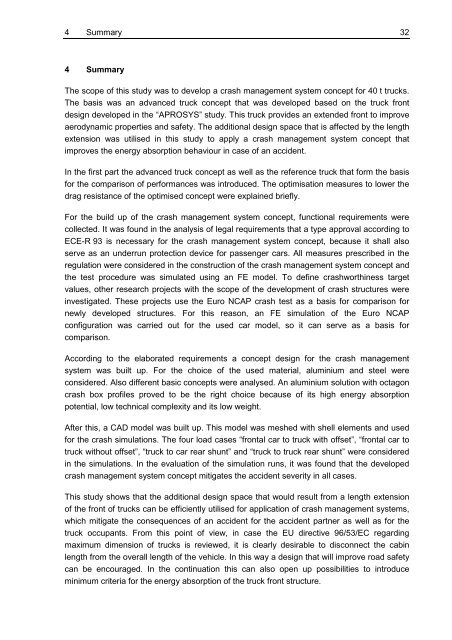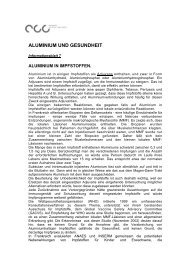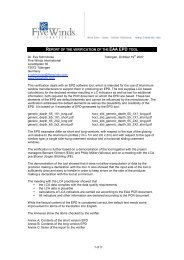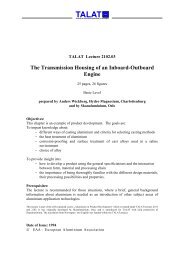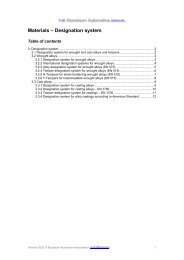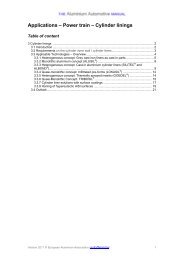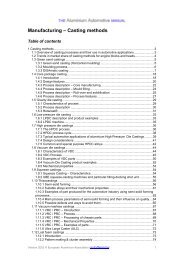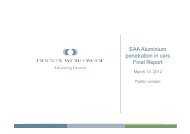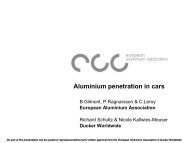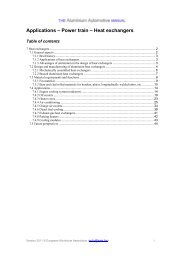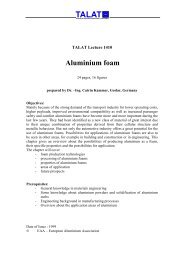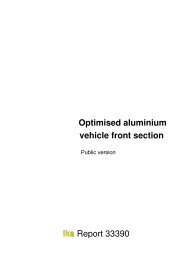Report 106310 Concept Design of a Crash Management System for ...
Report 106310 Concept Design of a Crash Management System for ...
Report 106310 Concept Design of a Crash Management System for ...
You also want an ePaper? Increase the reach of your titles
YUMPU automatically turns print PDFs into web optimized ePapers that Google loves.
4 Summary 32<br />
4 Summary<br />
The scope <strong>of</strong> this study was to develop a crash management system concept <strong>for</strong> 40 t trucks.<br />
The basis was an advanced truck concept that was developed based on the truck front<br />
design developed in the “APROSYS” study. This truck provides an extended front to improve<br />
aerodynamic properties and safety. The additional design space that is affected by the length<br />
extension was utilised in this study to apply a crash management system concept that<br />
improves the energy absorption behaviour in case <strong>of</strong> an accident.<br />
In the first part the advanced truck concept as well as the reference truck that <strong>for</strong>m the basis<br />
<strong>for</strong> the comparison <strong>of</strong> per<strong>for</strong>mances was introduced. The optimisation measures to lower the<br />
drag resistance <strong>of</strong> the optimised concept were explained briefly.<br />
For the build up <strong>of</strong> the crash management system concept, functional requirements were<br />
collected. It was found in the analysis <strong>of</strong> legal requirements that a type approval according to<br />
ECE-R 93 is necessary <strong>for</strong> the crash management system concept, because it shall also<br />
serve as an underrun protection device <strong>for</strong> passenger cars. All measures prescribed in the<br />
regulation were considered in the construction <strong>of</strong> the crash management system concept and<br />
the test procedure was simulated using an FE model. To define crashworthiness target<br />
values, other research projects with the scope <strong>of</strong> the development <strong>of</strong> crash structures were<br />
investigated. These projects use the Euro NCAP crash test as a basis <strong>for</strong> comparison <strong>for</strong><br />
newly developed structures. For this reason, an FE simulation <strong>of</strong> the Euro NCAP<br />
configuration was carried out <strong>for</strong> the used car model, so it can serve as a basis <strong>for</strong><br />
comparison.<br />
According to the elaborated requirements a concept design <strong>for</strong> the crash management<br />
system was built up. For the choice <strong>of</strong> the used material, aluminium and steel were<br />
considered. Also different basic concepts were analysed. An aluminium solution with octagon<br />
crash box pr<strong>of</strong>iles proved to be the right choice because <strong>of</strong> its high energy absorption<br />
potential, low technical complexity and its low weight.<br />
After this, a CAD model was built up. This model was meshed with shell elements and used<br />
<strong>for</strong> the crash simulations. The four load cases “frontal car to truck with <strong>of</strong>fset”, “frontal car to<br />
truck without <strong>of</strong>fset”, “truck to car rear shunt” and “truck to truck rear shunt” were considered<br />
in the simulations. In the evaluation <strong>of</strong> the simulation runs, it was found that the developed<br />
crash management system concept mitigates the accident severity in all cases.<br />
This study shows that the additional design space that would result from a length extension<br />
<strong>of</strong> the front <strong>of</strong> trucks can be efficiently utilised <strong>for</strong> application <strong>of</strong> crash management systems,<br />
which mitigate the consequences <strong>of</strong> an accident <strong>for</strong> the accident partner as well as <strong>for</strong> the<br />
truck occupants. From this point <strong>of</strong> view, in case the EU directive 96/53/EC regarding<br />
maximum dimension <strong>of</strong> trucks is reviewed, it is clearly desirable to disconnect the cabin<br />
length from the overall length <strong>of</strong> the vehicle. In this way a design that will improve road safety<br />
can be encouraged. In the continuation this can also open up possibilities to introduce<br />
minimum criteria <strong>for</strong> the energy absorption <strong>of</strong> the truck front structure.


